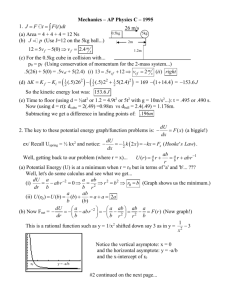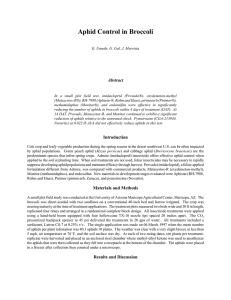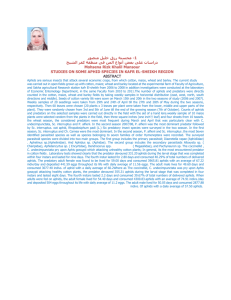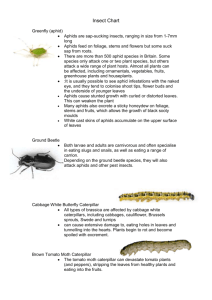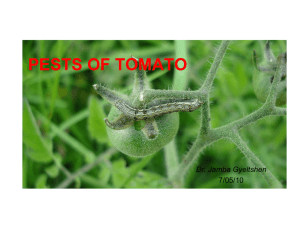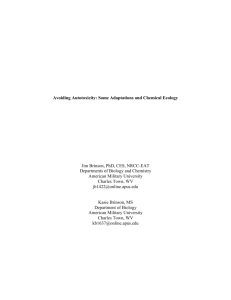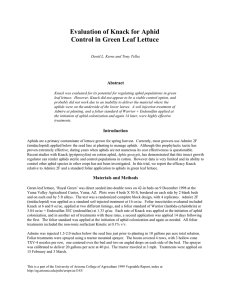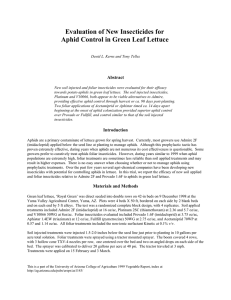EFFECT OF APHIDS ON TOMATO PRODUCTION
advertisement
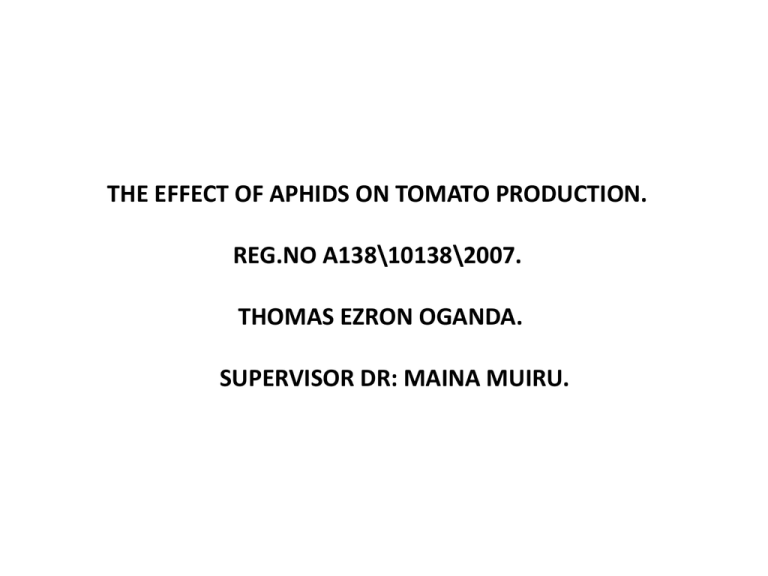
THE EFFECT OF APHIDS ON TOMATO PRODUCTION. REG.NO A138\10138\2007. THOMAS EZRON OGANDA. SUPERVISOR DR: MAINA MUIRU. INTRODUCTION 1 .Tomato production in Kenya In Kenya tomato producing areas are mainly, Kirinyaga,Murang’a, Nyeri and Kiambu. They are mainly grown for local consumption as fresh or processed products and as an export crop. 2. Economic importance of tomatoes They are cooked as fresh vegetable or used for making source or eaten as a salad. They contain vitamin A and C. They fetch ready cash to farmers and traders. Source of employment/income. For medicinal purposes e.g. lycopersicon is used to treat heart diseases 3. Constraints in tomato production Diseases e.g. tomato blight, early blight an bacterial wilt Weeds, they compete for nutrients, they harbor pests and act as alternative host and diseases Non biotic factors e.g. low prices due to low quality fruits and marketing problems and poor storage facilities. Natural calamities e.g. heavy rainfall and sudden environmental changes. Insects e.g. grass hoppers, crickets, aphids and wire worms. 4. Problem statement and justification Aphid are quite devastating if no steps are taken to control them, this has affected commercial production of tomatoes in areas of high relative humidity. It is therefore necessary to conduct a research to verify the effect of aphid s on the total productivity of tomatoes and sect the best control method that can ensure optimum yields. OBJECTIVE. To determine the efficacy of biocatch on aphid on tomato plants To determine the effect of the product(biocatch on yield of tomatoes when applied at different rates). MATERIALS AND METHODS Location, the trial was carried out at the field station in the college of Agriculture and Veterinary sciences, Upper Kabete Campus, University of Nairobi. Crop establishment Certified tomato seeds of Roma variety were sown in a nursery where the seedlings were nurtured for four weeks and maintained free from pests and diseases. Plots measuring 4m x 3m were prepared and Diammonium Phosphate (D.A.P) fertilizer added at a rate of 5g per hill. Five plants per treatment were randomly selected for data collection Treatment effects were assessed by analysis of variance (ANOVA) using Gens tat 8.1 Release, while least significant difference (LSD) test was used to compare treatment means. The seedlings were then transplanted at a spacing of 90cm x 60cm to give a population of 30 plants per plot. The treatments were the four concentrations of the test chemical applied at the rate of 2.5kg, 3.75kg, 5kg, and 6.25kg/ha. The standard chemical check (Nimbecidine) was applied at the rate of 1.5L/Ha and the negative control (Water), making a total of six treatments. These treatments were arranged in a randomized complete block design with four replicates. The four concentrations of the test chemicals namely 2.5kg, 3.75kg, 5kg, and 6.25kg/ha were evaluated. These rates translated to 15g, 22.5g, 30g and 37.5g respectively dissolved in 6.0liters of water for each treatment. The standard Nimbecidine was applied at the rate of 1.5lt/ha, which was translated to 9ml dissolved in 6 liters of water and six liters of tap water, was used as the negative control. Pest Assessment, Three leaves from each of the sampled plant were obtained from the bottom, middle and top part of the plant and used to determine aphid population. In cases of heavy infestation, the leaves were subdivided into sections and aphids, were counted from one section and the total number of aphids worked out for all the sections. RESULTS The aphid population in tomatoes was significantly different (P 0.05) among treatments and sampling periods (Table 1, Appendix, 8.1). The highest reduction in aphid population occurred when 6.25kg/ha Bio-Catch was applied while the least was observed at 2.5kg/ha level. Bio-Catch at the rates of 3.75kg/ha was more effective in aphid management compared to that of 2.5kg in the second, third and fourth samplings. Efficacy against aphids Table 1. Mean counts of aphids after application of different treatments Treatment Applicat ion Rate Bio-Catch 2.5kg/ha Bio-Catch 3.75kg/h a 5kg/ha 6.25kg/h a 2.5kg/ha Bio-Catch Bio-Catch Nimbecidine Negative control CV%(P0.05) Lsd Pretreatme nt Populat ion 95.5 1 2 Sampling period 3 4 5 6 29.8b 95.9 15.8 38.7b b 11.0b 22.6c 21.8c 10.6 31.3 b b 5.3bc 4.9c 82.7 3.9bc 14.3d 22.0c 1.8c 1.9c 83.6 2.7c 22.1c 0.8c 1.7c 44.1a b 37.3 b 50.7a 83.6 2.2c 0.9c 0.9c 7c 83.6 68.0a 97.4a 26.5b c 128.4 a 12.9 7.11 15.7c d 9.3d 46.6a 97.8a 214.9 46.6a a Effect on tomato yield. The yield increase over time was highly significant (P 0.05) (Appendix 8.2). The yields from the third harvest were significantly (P 0.05) different from other harvests (Table 2). Plants treated with Bio-Catch at the rate of 5kg/ha gave the highest yields while plants from the negative control yielded the least. However there was no significant difference (P 0.05) in yield from the different treatments Table2. Mean tomato yield at different times of harvesting Time of Harvesting Mean 1 353.66b 2 360.17b 3 808.05a 4 427.23b 5 433.75b CV (P 0.05) 1.988 LSD 112.97 DISCUSSION The results of the trial showed that Bio-Catch (Verticillium lecanii 1.5%) was effective in the management of aphids. Bio-Catch effectively controlled aphids on young plants that produced enough flush, a requirement for the development and reproduction of these pests. This molecule has a great potential to control the pest and would be of great benefit to the farmers. Bio-Catch applied at the rates of 5.0 and 6.25kg/ha was comparable in efficacy in all the sampling periods apart from the second and 6th samplings where the latter was more effective. CONCLUSIONS AND RECOMMENDATION Bio-Catch can be recommended for the effective control of aphids at the rate of 5.0kg/ha. Repeated sprays can be applied up to three times against aphids whenever they reach the threshold levels till the population is brought below the economic injury level. THANK YOU.
